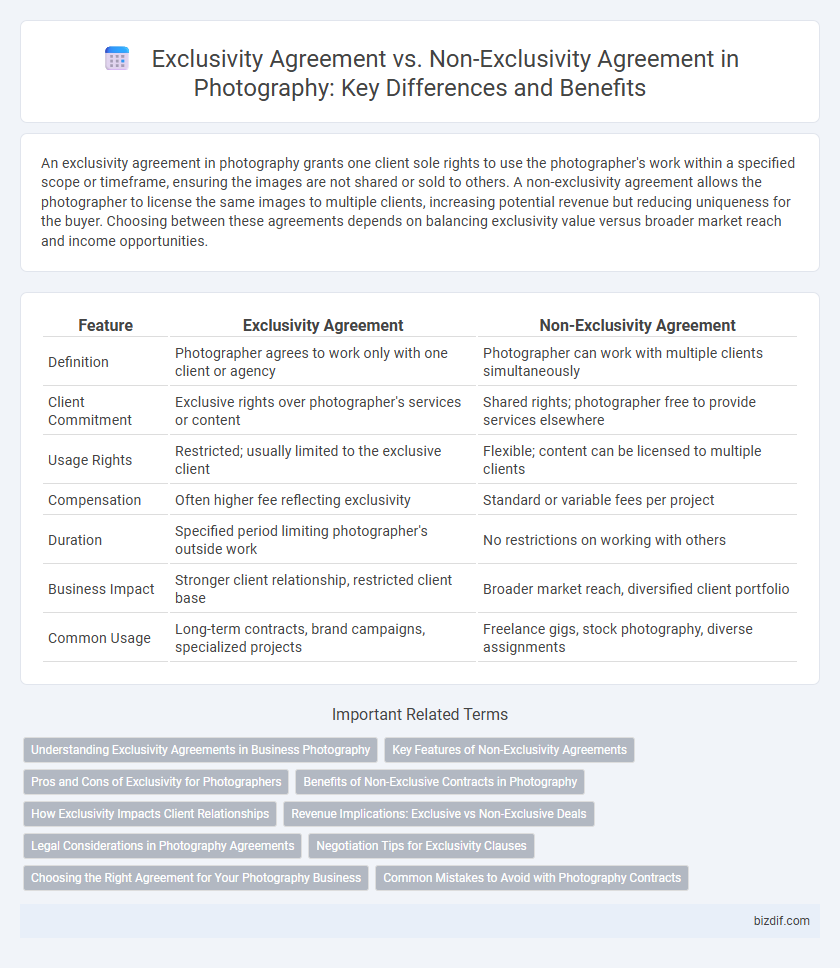An exclusivity agreement in photography grants one client sole rights to use the photographer's work within a specified scope or timeframe, ensuring the images are not shared or sold to others. A non-exclusivity agreement allows the photographer to license the same images to multiple clients, increasing potential revenue but reducing uniqueness for the buyer. Choosing between these agreements depends on balancing exclusivity value versus broader market reach and income opportunities.
Table of Comparison
| Feature | Exclusivity Agreement | Non-Exclusivity Agreement |
|---|---|---|
| Definition | Photographer agrees to work only with one client or agency | Photographer can work with multiple clients simultaneously |
| Client Commitment | Exclusive rights over photographer's services or content | Shared rights; photographer free to provide services elsewhere |
| Usage Rights | Restricted; usually limited to the exclusive client | Flexible; content can be licensed to multiple clients |
| Compensation | Often higher fee reflecting exclusivity | Standard or variable fees per project |
| Duration | Specified period limiting photographer's outside work | No restrictions on working with others |
| Business Impact | Stronger client relationship, restricted client base | Broader market reach, diversified client portfolio |
| Common Usage | Long-term contracts, brand campaigns, specialized projects | Freelance gigs, stock photography, diverse assignments |
Understanding Exclusivity Agreements in Business Photography
Exclusivity agreements in business photography ensure that a photographer or agency provides services solely to one client within a specified period or project scope, protecting the client's market position and creative assets. These agreements typically restrict the photographer from working with competitors or similar businesses, fostering brand consistency and unique visual identity. Understanding the terms and limitations of exclusivity agreements helps both photographers and clients manage expectations, avoid conflicts, and maximize the value of their professional relationship.
Key Features of Non-Exclusivity Agreements
Non-Exclusivity Agreements in photography allow photographers to license their images to multiple clients simultaneously, increasing exposure and revenue potential. These agreements typically include flexible usage rights, enabling broader distribution without restricting the photographer's ability to sell the same content elsewhere. Key features also encompass non-exclusive licensing terms, minimal restrictions on image use, and retention of copyright ownership by the photographer.
Pros and Cons of Exclusivity for Photographers
Exclusivity agreements in photography offer photographers guaranteed work and stronger brand association with a single client, enhancing income stability but limiting opportunities to collaborate with other potential clients and diversify their portfolio. These agreements often result in higher negotiation power and tailored project requirements, yet they can restrict creative freedom and lead to income dependency on one source. Photographers must weigh the security of exclusive contracts against the flexibility and broader exposure provided by non-exclusivity agreements.
Benefits of Non-Exclusive Contracts in Photography
Non-exclusive contracts in photography allow photographers to collaborate with multiple clients simultaneously, increasing income potential and diversifying their portfolio. These agreements provide greater flexibility, enabling photographers to maintain creative freedom without being tied to a single brand or project. By avoiding exclusivity, photographers can adapt quickly to market demand and seize varied opportunities in a competitive industry.
How Exclusivity Impacts Client Relationships
Exclusivity agreements in photography foster stronger client relationships by guaranteeing photographers sole rights to provide services, enhancing trust and commitment. Clients benefit from a dedicated photographer who prioritizes their brand's visual identity, leading to more consistent and personalized results. Non-exclusivity agreements, by contrast, may dilute client loyalty as photographers balance multiple clients with overlapping interests.
Revenue Implications: Exclusive vs Non-Exclusive Deals
Exclusive photography agreements typically generate higher revenue per client by limiting service availability to a single provider, which often results in premium pricing and stronger brand attachment. Non-exclusive agreements allow photographers to work with multiple clients simultaneously, increasing volume but potentially lowering individual contract values due to competitive pricing. Revenue implications hinge on balancing exclusivity's higher margins against non-exclusivity's broader market access and scalability.
Legal Considerations in Photography Agreements
Photography agreements with exclusivity clauses restrict photographers from working with competitors, strengthening legal protection over intellectual property and usage rights. Non-exclusivity agreements allow photographers to license images to multiple clients, requiring careful definition of usage scope and duration to avoid legal conflicts. Clear terms on copyright ownership, usage limitations, and termination conditions are essential to mitigate risks in both exclusive and non-exclusive photography contracts.
Negotiation Tips for Exclusivity Clauses
When negotiating exclusivity clauses in photography agreements, prioritize clearly defining the scope and duration of exclusivity to avoid overly restrictive terms that limit your creative freedom. Specify the geographic regions and types of work covered to prevent unintended limitations on future projects. Insist on fair compensation that reflects the potential impact on your ability to take other assignments during the exclusivity period.
Choosing the Right Agreement for Your Photography Business
Exclusivity agreements in photography secure a photographer's services for a single client, enhancing brand loyalty and stable income, while non-exclusivity agreements allow photographers to work with multiple clients, increasing exposure and diverse revenue streams. Selecting the right contract depends on business goals--exclusivity suits photographers seeking focused partnerships and consistent work, whereas non-exclusivity benefits those aiming for flexibility and broader market reach. Understanding terms like usage rights, duration, and compensation structure is crucial for tailoring agreements that protect intellectual property and maximize profitability.
Common Mistakes to Avoid with Photography Contracts
Common mistakes to avoid in photography contracts include misunderstanding the terms of exclusivity and non-exclusivity agreements, which can lead to unintended limitations on portfolio usage or client assignments. Photographers often overlook specifying clear usage rights and duration, causing disputes over image ownership and licensing scope. Ensuring precise definitions and restrictions in exclusivity clauses prevents conflicts and safeguards both creative control and income potential.
Exclusivity Agreement vs Non-Exclusivity Agreement Infographic

 bizdif.com
bizdif.com